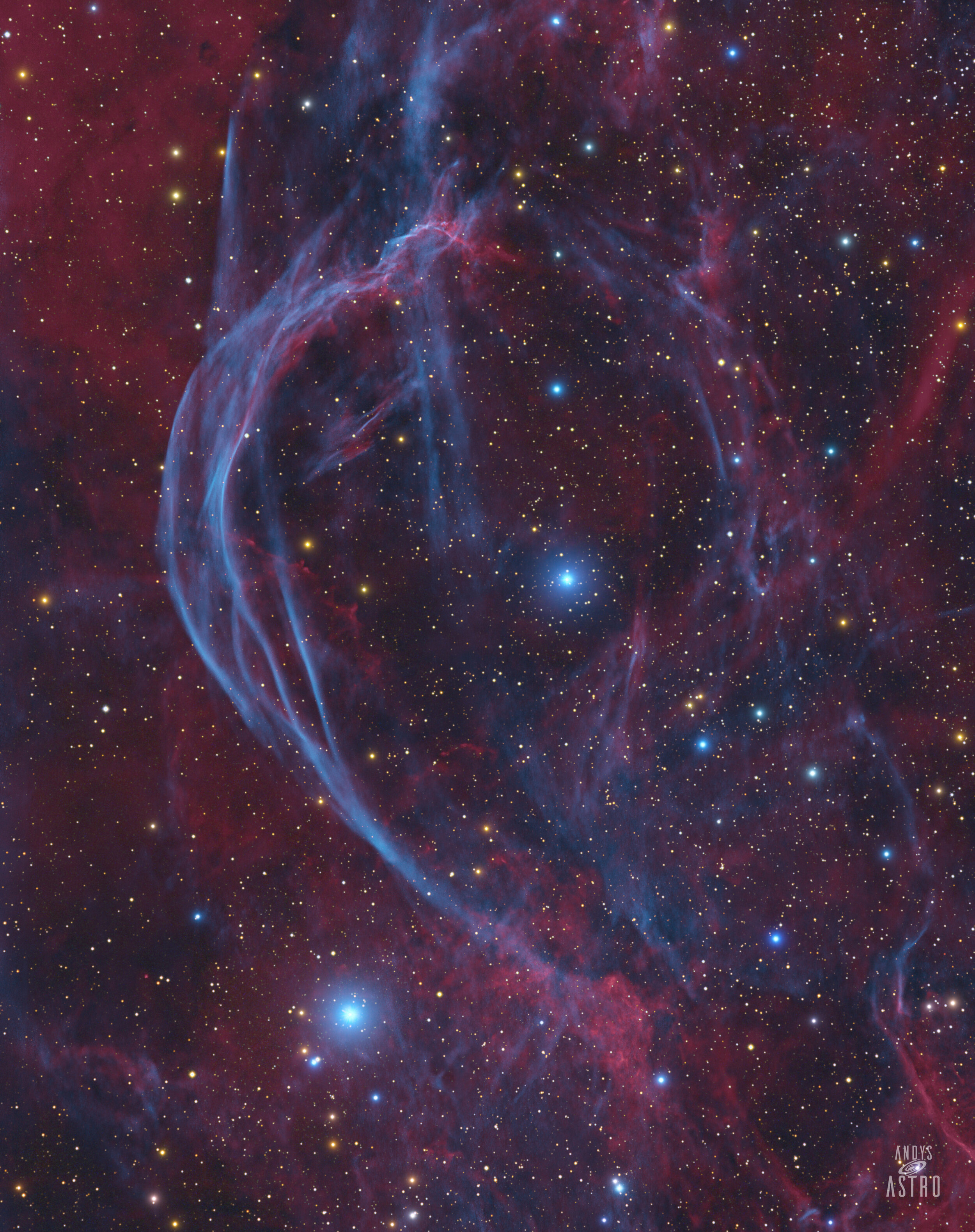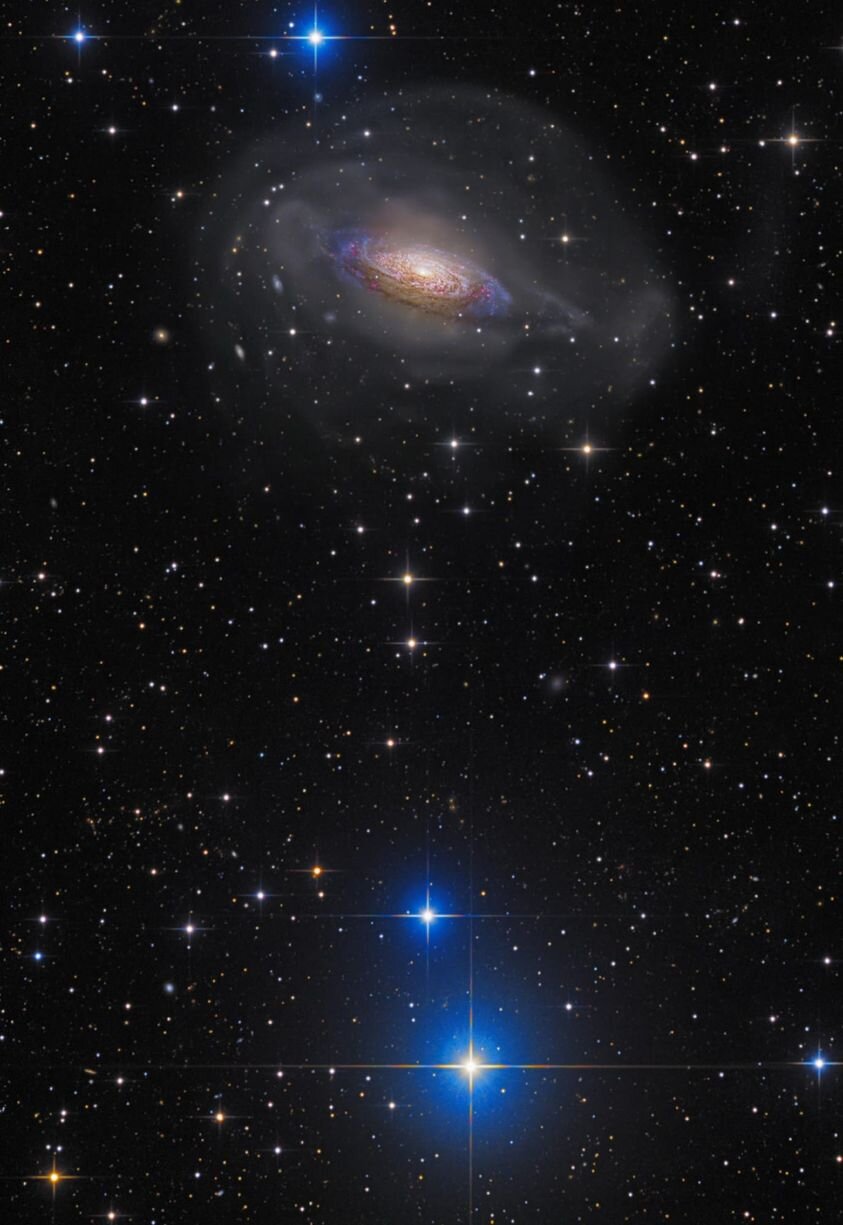
AAPOD2 Image Archives
Polar Alignment
150x 100sec images for the trails, 3x 1 second images of my scope, lightly light painted
Canon 6D and Samyang 135mm f2 @ f2.8
Copyright: Carl Gough
NGC 1398 Galaxy
Image Description and Details :
The galaxy NGC1398 is located 65 million light years away, in the constellation of Fornax.
It's diameter is about 135,000 light years, slightly larger than our Milky Way.
The nucleus of this galaxy is surrounded by a ring ; and the whole galaxy is also surrounded by an outer ring.
Image made using the 1m telescope at Chilescope in LRGB-Ha.
Setup : RC 1m - Alt-Az mount - FLI ProLine16803 - Astrodon filters - Chilescope remote facility
LRGB + Ha
Total integration : 11h20
Copyright : Jean-Baptiste Auroux
Reaching for the Stars
Have you ever wondered what a future Mars base may look like? For me, the Observatoire de la Côte d’Azur on the Plateau de Calern is the perfect model for such a station.
The futuristic looking buildings in the foreground are the working quarters of the Grand Interferometer of 2 Telescopes (GI2T) and the cupolas in the background on far right belong to the Soirdete Infrared Interferometer. The green laser is emitted from the 1.5m telescope of the MéO laser ranging observatory, which is able to track low earth orbit satellites and can measure the distance to the moon to a precision of under 1cm.
The sky above the observatory suffers from light pollution from the brightly lit Côte d’Azur and the nearby city of Nice, but still proves that the dimmer side of the Milky Way with its red Hydrogen emission nebulas, countless open clusters, dark interstellar dust lanes is sparkling with celestial wonders. The bright Andromeda Galaxy and the Triangulum Galaxy are sharing the same region of the sky.
EXIF
Canon EOS 6D, astro-modified
Samyang 24mm f/1.4 @ f/2
iOptron SkyTracker Pro
Sky:
Vertical panorama of 3 panels, each a stack of 5 x 30s @ ISO1600, tracked
Foreground:
Stack of 5 x 60s @ISO1600
Copyright: Ralf Rohner
NGC 3981
Image Description and Details :
This is an image of NGC 3981. It is a spiral galaxy about 65 million light years away in the constellation Crater. Its windswept look is due to its outer arms being stripped away by an interaction with another galaxy. Telescope: ASA RC-1000AZ Camera: FLI PL16803 Mount: ASA Alt-Az Direct Drive Luminance: 33x20 minutes (binned 1x1)Red: 24x20 minutes (binned 1x1) Green: 20x20 minutes (binned 1x1) Blue: 25x20 minutes (binned 1x1)
Copyright: Bernard Miller
Abell 34
Image Description and Details :
Abell 34 - a large (290 arc seconds) but very faint planetary nebula about 2400 light years away in the constellation Hydra. It's western rim is accompanied by two tiny distant galaxies.Image captured on my dual rig in Spain.Scopes: APM TMB LZOS 152 RefractorsCameras: QSI6120wsg8Mount: 10Micron GM2000 HPSA total of 25.8 hours image capture (HaOIIILRGB)
Copyright: Peter Goodhew
Blue Chilli Nebula
Image Description and Details :
Resembling a hot chilli these superheated blue tendrils of ionised oxygen are remnants of a spectacular supernova that occurred some 11,000 years ago.Located in Vela some 800 LY distant, this small isolated section of this vast region silhouetted against a background rich in Ha seemed worthy of attention it’s own right - as after an exhaustive search, there don’t appear to be any stand alone studies online of this beautiful waveform.Photographed over three nights from my light polluted suburban backyard in Melbourne, Australia. 🇦🇺Acquisition was made using Stellarmate on a Rpi4 Processed in App, PS CC 2021, Topaz NR Ai & Nik.Captured via Stellarmate- 15.0 Hrs HaO3RGB Average seeing, Bortle 5/6 skies.Telescope : Takahashi TOA130 Mount: Takahashi NJPCamera: QSI 6162 WSG8 Filters: Chroma Ha 5nm, Chroma O3 3nm Chroma RG&BProcessed in Astropixel Processor Topaz AI & Photoshop CC 2021
Copyright: Andy Campbell 2021
Mars: Progression to opposition
Image Description and Details :
A sequence of 20 images of Mars taken during 8 months that shows the changes of apparent size, ilumination and the southern polar cap of the red planet. From Santo Domingo, Dominican Republic.Equipment: Telescope Orion Skyquest XT8 Plus, Equatorial Platform, ZWO ASI120MC & ZWO ASI290MC, ZWO ADC, Celestron X-Cel 3x Barlow Lens.
Copyright: C. Báez
Widefield Auriga
Image Description and Details :
This was shot over the course of 18 nights, spanning 4 months (winter skies in Nashville aren't the greatest). The Canon lens was @ f/4.
The real challenge with this photo came from the Spaghetti Nebula (aka SH2-240, Simeis 147). It's incredibly dim and barely shows up in a single 20 minute sub, which is in stark contrast to brightness of the Flaming Star Nebula (IC 405, SH 2-229, or Caldwell 31) and Tadpoles Nebula (IC 410, NGC 1893). I had to process this as HDR so that they appeared to have the same brightness.
Imaging lens: Canon EF 85 mm f/1.8 USM
Imaging cameras: ZWO ASI2600MC Pro
Mounts: Sky-Watcher EQ6R-PRO
Guiding telescopes or lenses: ZWO Mini Guide Scope
Guiding cameras: ZWO ASI290MM Mini
Software: Pleiades Astrophoto PixInisight · Photoshop CC
Filters: Optlong L-eXtreme 2" · Optolong L-eNhance 2"
Accessory: ZWO AsiAir Pro
Dates:
Dec. 10, 2020, Dec. 11, 2020, Dec. 13, 2020, Dec. 18, 2020, Dec. 21, 2020, Dec. 22, 2020, Jan. 6, 2021, Jan. 13, 2021, Jan. 14, 2021, Feb. 4, 2021, Feb. 8, 2021, March 4, 2021, March 5, 2021, March 7, 2021, March 8, 2021, March 9, 2021, March 10, 2021, March 11, 2021
Frames:
Optolong L-Pro 2'': 40x15" (gain: 100.00) -10C bin 1x1
Optolong L-Pro 2'': 40x30" (gain: 100.00) -10C bin 1x1
Optolong L-Pro 2'': 40x60" (gain: 100.00) -10C bin 1x1
Optolong L-eNhance 2": 143x1200" (gain: 100.00) -10C bin 1x1
Optolong L-eXtreme 2": 56x1200" (gain: 100.00) -10C bin 1x1
Integration: 67.5 hours
Darks: ~40
Bortle Dark-Sky Scale: 8.00
Copyright: Jeffrey Horne
SNR 110.3 + 11.3, DeHt 5 and vdB 152
Telescope / Mount / Guiding
ASA 10" Astrograph, ASA 3" Wynne-Corrector (focal length 910mm)ASA DDM60, no guiding
Camera / Exposure
Canon 6D
73 x 10min
Moravian G3-16200, Astrodon filters
L 45 x 3min bin 2x2, 41 x 3min bin 2x2 Hα 2 x (21 x 20min) OIII 2 x (18 x 10min) bin 2x2
Total exposure time: 36h 28min
Processing
PixInsight, Fitswork, Photoshop
Notes
This image took me more than 7 years to create. The first time I shot with an unmodified Canon 6D in 2013. But was not satisfied with the data after I had the opportunity to process Frank Sackenheim's CCD data of the same object (here or on Frank's homepage). In 2018 I made attempts with luminance shots in 2x2 binning with a Moravian G3-16200 (due to the bigger sensor of the Canon 6D now as 2 panel mosaic), but I have not continued this project. In summer 2020 I found this old data again, added additional Luminance-data and new Halpha- and OIII-data and finally tried to create an image with these old and new data.
The red streakes crossing the image in diagonal direction are a small part of the huge supernova remnant SNR 110.3+11.3 in the constellation Cepheus. It is one of the nearest supernova remnants and only 1300 light years away from earth. These shocked molecular gas filaments were discovered and catalogued in 2001 by John Bally and Bo Reipurth.
Van den Berg (vdB) 152 is a blue reflection nebula that glows at the bottom of a dark Bok globule called Barnard 175. Near the edge of a large molecular cloud, interstellar dust in the region blocks most of the starlight behind it or scatter light from the embedded bright star giving parts of the nebula a characteristic blue color. Ultraviolet light from the star is also thought to cause a dim reddish luminescence in the nebular dust.
Embedded in the left side of the nebula is the Herbig Haro object HH 450, a jet emitted from a newly forming star.
Dengel-Hartl (DeHt) 5 is a HII- and OIII-region, maybe an ancient planetary nebula, ionized by the white dwarf WD 2218+706 (the blue star in the center of the nebula). Beverly Lynds catalogued the brighter part as LBN 538.
Copyright: Thomas Henne
A deep view of NGC 3521
Gorgeous spiral galaxy NGC 3521 is a mere 35 million light-years away, toward the constellation Leo. Relatively bright in planet Earth's sky, NGC 3521 is easily visible in small telescopes but often overlooked by amateur imagers in favor of other Leo spiral galaxies, like M66 and M65. It's hard to overlook in this colorful cosmic portrait, (APOD)
***Processing Information till now this has been the most difficult object to process, i spent more than 20+hrs processing this galaxy, i used Photoshop,ccd stack and pixinsight,structure pulling was mainly done by layers and mask, as it was quite dim so combination of noise reduction and masking helped a lot , adding more tone to structure was done in Pixinsight thanks to dear friend marcel for some final color correction. Ps : the signal was way to faint so only option was these
All data shot from Remote observatory
technical Details : 16"F3.7 Dream Scope Astrograph, FLI PL16803 CCD,BadderLRGBha filters Around 291Mins of L 125mins of Red Green Blue 600sec X 6 Bin 2x2 halpha 11.85 hrs total LRGBha Data under Prestine Dark skies of New Mexico
Copyright: Utkarsh Mishra,Michael Petrasko,Muir Evenden











